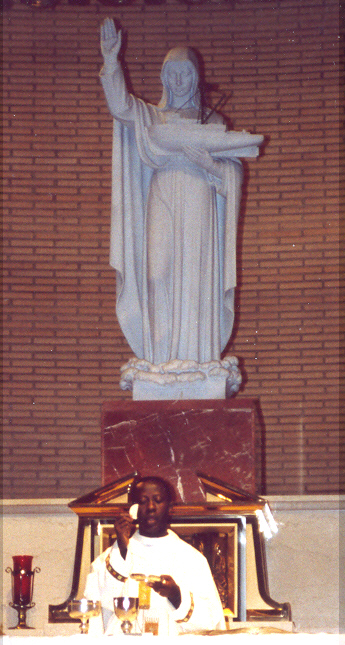
Return to
Index The Catholic Faith
Return to Level
Two Topic Index
Home Page
The COMMUNION RITE follows the Eucharistic Prayer in the Liturgy of the Eucharist. The sacred Victim, accepted by the Father - since it is his own divine Son - is now given back to us as the greatest gift we can receive.
At the conclusion of the Canon, after the people say "Amen", the priest puts down the chalice and the paten with the Host and says: "Let us pray with confidence to the Father in the words our Savior gave us." Then we join in the Our Father in order to praise God and place our petitions before him. This is the prayer that Our Lord himself taught us as the model for all our prayers. It is certainly fitting, as we pause in the action of the Mass, to reach out to God the Father with these words in which Jesus taught his apostles to pray simply, with confidence and love.
The Our Father, called the perfect prayer, contains all the spiritual ingredients we need to move us into a close and loving family, the People of God. Jesus taught us to say "our" Father, not "my" Father, because God wishes to live with us in a community. As God has said so many times in the Old Testament: "I will be your God and you will be my people".
My Peace I Give You
St. Paul, in his letter to the Philippians, speaks of the peace of God "which is beyond all understanding" (Phil 4:7). This priceless treasure of peace is Christ's gift to us. At the Last Supper, Christ says: "Peace is my farewell to you, may peace is my gift to you: I do not give it to you as the world gives peace. Do not be distressed or fearful" (Jn 14:27).
At this point in the Mass we may offer each other a sign of Christ's peace, the peace of forgiveness and the reassurance of having his mercy and love. To preserve this gift we must seek to live in peace every day with family and friends and everyone we meet.
As the Rite of Peace ends, the priest takes the Host and breaks it over the paten. He places a small piece in the chalice, saying quietly: "May this mingling of the Body and Blood of our Lord Jesus Christ bring eternal life to us who receive it." Meanwhile, everyone prays: "Lamb of God, you take away the sins of the world, have mercy on us . . . grant us peace."

Jesus, of course, is the "Lamb of God": he takes away the sins of the world. The Paschal lamb that is eaten by Jewish families to celebrate the Passover which freed the Israelites from the Egyptians is a a symbol of the true Paschal Lamb who frees us from the slavery of our sins.
I Am Not Worthy
Close to Communion now, we repeat the words of a Roman Centurion who once asked Jesus to save one of his servants from death. The Centurion entreated Jesus not to bother coming to his house, since he did not consider himself worthy to receive Jesus, but simply to give the word and his servant would be cured. Jesus marveled at this man's faith and granted his request. Now we, too, say as the Centurion did: "Lord, I am not worthy to receive you, but only say the word and I shall be healed." Then the priest takes Communion, and the Communion Antiphon is recited or sung.
Finally we go up to receive Holy Communion. The priest holds the Host before the communicant, and says: "The Body of Christ", to which the communicant answers: "Amen." When we "Amen" we are saying: "Yes, I believe that this is really Jesus Christ." If we are unable to receive Communion for some reason we should use the time to pray and ask Jesus to be present with us.
Giving Thanks
Receiving the Sacrament allows us to be alone with God in a private way. It is one of the best chances we have to thank Jesus for everything he gives us - especially the gift of his Body and Blood.
There is an incident in the Gospel in which Jesus cures ten lepers. They were cured as they were on their way to show themselves to the priests as Jesus directed. Only one of them returned to Jesus to thank him. Let's remember to be grateful to Jesus for coming to us in Holy Communion. How do we welcome him? Do we receive him on our tongue or in our hand and then close our mind and heart to him? Do we at least keep him company for five or ten minutes?
When Communion has been distributed, the priest cleans the paten over the chalice and then cleans the chalice itself. The people have a chance to pray quietly. The priest may sit down for a time to continue the silence and thanksgiving. Then, standing at the chair or at the altar, the priest says the Prayer after Communion, which asks that our share in the Eucharist be fruitful. The Blessing in the name of the Trinity follows, and the priest declares: "The Mass is ended, go in peace." The People answer: "Thanks be to God."
There may be a Closing Hymn (Recessional) as the priest leaves the altar. After Mass, we should try to spend some time - however brief - alone with Jesus. We may pray for ourselves; for the Church, the pope, priests, and religious; for our families, friends, and others. A prayer book with a selection of prayers for thanksgiving after Communion may be a big help.
Used with the permission of The Ignatius Press 800-799-5534
Return to
Index The Catholic Faith
Return to Level
Two Topic Index
Top
Home Page